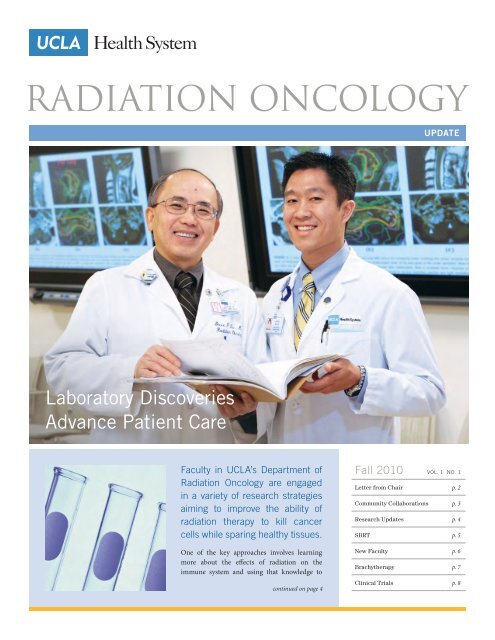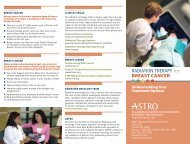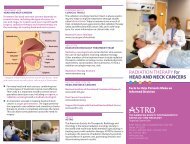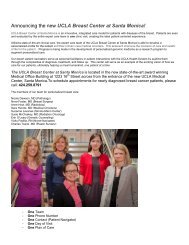View Newsletter (PDF) - Radiation Oncology - UCLA
View Newsletter (PDF) - Radiation Oncology - UCLA
View Newsletter (PDF) - Radiation Oncology - UCLA
Create successful ePaper yourself
Turn your PDF publications into a flip-book with our unique Google optimized e-Paper software.
<strong>Radiation</strong> oncology<br />
Update<br />
Laboratory Discoveries<br />
Advance Patient Care<br />
Faculty in <strong>UCLA</strong>’s Department of<br />
<strong>Radiation</strong> <strong>Oncology</strong> are engaged<br />
in a variety of research strategies<br />
aiming to improve the ability of<br />
radiation therapy to kill cancer<br />
cells while sparing healthy tissues.<br />
One of the key approaches involves learning<br />
more about the effects of radiation on the<br />
immune system and using that knowledge to<br />
continued on page 4<br />
Fall 2010 Vol. 1 No. 1<br />
Letter from Chair p. 2<br />
Community Collaborations p. 3<br />
Research Updates p. 4<br />
SBRT p. 5<br />
New Faculty p. 6<br />
Brachytherapy p. 7<br />
Clinical Trials p. 8
From the chair<br />
Leading the Way Toward<br />
Better Cancer Outcomes<br />
It’s hard to find anyone who hasn’t been intimately touched by cancer. If we<br />
haven’t had the disease ourselves, we’ve gone through it with a close friend or<br />
family member. Sadly, many of us have lost loved ones. This year, according<br />
to the World Health Organization, cancer will overtake heart disease as the<br />
world’s leading killer.<br />
“Driving our excellence in<br />
clinical care and teaching<br />
is our research — in the<br />
laboratory, in the clinic<br />
and in the translation<br />
from one to the other.”<br />
— Michael Steinberg, M.D.<br />
But more than ever before, we are poised to<br />
make rapid progress in cancer treatment. At<br />
leading research institutions, scientists are<br />
unraveling the biology involved in the cancer<br />
process — and using that understanding to<br />
apply the ever-more-powerful arsenal of<br />
diagnostic and therapeutic technologies to<br />
cancer treatment.<br />
Nowhere is this better exemplified than at<br />
<strong>UCLA</strong>. In the Department of <strong>Radiation</strong><br />
<strong>Oncology</strong>, we are an integral part of a worldclass<br />
clinical, translational and basic scientific<br />
research infrastructure that enables our faculty<br />
to rapidly integrate advances in molecular<br />
biology, radiation biology and medical imaging<br />
of cancer with the new and highly precise<br />
techniques in radiation delivery, improving<br />
patient care and treatment outcomes. That is<br />
the <strong>UCLA</strong> advantage.<br />
Within our department, an extraordinary<br />
team of physicians, medical physicists and<br />
research scientists work together to deliver<br />
state-of-the-art patient care. But as important<br />
as this is to our mission, it’s not enough. We are<br />
also determined to press the <strong>UCLA</strong> advantage<br />
to advance the state of the art in treating cancer<br />
with radiation therapy. And we are doing just<br />
that — through the development and testing of<br />
new treatments and technologies, the training<br />
of the next generation of outstanding<br />
physicians and scientists, and the outreach<br />
efforts designed to bring our knowledge to the<br />
community and improve the safety and efficacy<br />
of radiation therapy.<br />
As the articles in this inaugural issue of our<br />
newsletter attest, we are increasingly defining<br />
the state of the art. Long gone are the days<br />
when radiation therapy meant “dropping a<br />
bomb” on the tumor, hoping to kill as many<br />
cancer cells as possible while accepting the<br />
injury to healthy tissues as collateral damage.<br />
At <strong>UCLA</strong>, we have become far more precise as<br />
we take aim at the cancer with more intense<br />
doses that spare surrounding normal tissues.<br />
This is partly thanks to our ability to see the<br />
cancer — both before and during treatment —<br />
with the most powerful imaging tools,<br />
including four-dimensional PET and CT<br />
scanners. It is also due in part to our use of<br />
the most technologically advanced treatment<br />
delivery systems.<br />
As you will read, we have significantly<br />
strengthened our department with the<br />
recruitment of pioneers and innovators of<br />
cutting-edge radiation oncology treatments.<br />
In the exciting area of stereotactic body<br />
radiation therapy (SBRT), which shortens<br />
treatment time while reducing side effects,<br />
we are applying this technology in new ways,<br />
such as in the treatment of prostate, kidney,<br />
pancreas, and recurrent head and neck cancer.<br />
Our new fully dedicated brachytherapy suite<br />
houses a team headed by nationally known<br />
Dr. Jeffrey Demanes that is performing<br />
complex interstitial implants and high dose<br />
rate brachytherapy procedures. We have a<br />
new chief in our Division of Medical Physics,<br />
Dr. Daniel Low, who brings a strong vision<br />
and a history of NIH-supported research and<br />
collaborations with companies to develop<br />
more powerful technologies. Dr. Patrick<br />
Kupelian, professor and vice chair of the<br />
Department of <strong>Radiation</strong> <strong>Oncology</strong> and a<br />
www.RADoNC.<strong>UCLA</strong>.EDU
pioneer in the development of image-guidance<br />
technologies, is heading exciting new clinical<br />
research initiatives.<br />
Driving our excellence in clinical care and<br />
teaching is our research — in the laboratory,<br />
in the clinic and in the translation from one<br />
to the other. Our department brings in more<br />
than $6 million a year in grants — among<br />
the highest funding per faculty member at<br />
<strong>UCLA</strong>’s David Geffen School of Medicine.<br />
This includes a large award to establish the<br />
<strong>UCLA</strong> Center for Medical Countermeasures<br />
against <strong>Radiation</strong>, which is studying agents<br />
that could protect the population from<br />
radiation exposure resulting from a terrorist<br />
attack or a radiologic accident. Our basicscience<br />
faculty are leaders in the fields of<br />
cancer immunology, cancer stem cells and<br />
cancer signaling pathways, contributing<br />
knowledge that has led to new treatment<br />
strategies, which are having a major impact<br />
around the world. We are also developing<br />
the infrastructure to track patient outcomes<br />
longitudinally and in real time so that we can<br />
make better-informed treatment decisions.<br />
The patient registry, including data from our<br />
community partners, will also facilitate studies<br />
of comparative treatment approaches and<br />
cost analyses.<br />
The department’s mission is multifaceted,<br />
but characterized by a common thread: our<br />
dedication to providing compassionate care<br />
and advancing radiation treatment so that<br />
people diagnosed with the world’s leading<br />
killer can be returned to good health. After<br />
reading in this newsletter about some of the<br />
exciting developments underway, I hope you<br />
will agree we are making great progress.<br />
— Michael Steinberg, M.D., Chair<br />
<strong>UCLA</strong> Department of <strong>Radiation</strong> <strong>Oncology</strong><br />
Community Collaborations<br />
The Department of <strong>Radiation</strong> <strong>Oncology</strong><br />
has initiated an effort to actively engage<br />
its surrounding community. “Our simple<br />
aim is to improve the lives of our patients<br />
and the health of the community,” says<br />
Dr. Michael Steinberg, department chair.<br />
The department has been working<br />
with extramural clinics, filling their<br />
professional staffing needs with premier<br />
<strong>UCLA</strong> faculty physicians while responding<br />
to community needs for clinical expertise<br />
and access to cutting-edge clinical trials.<br />
In addition, through collaborations with<br />
community physicians across the greater<br />
Southern California area, the department<br />
is expanding participation in important<br />
clinical research that will allow for the<br />
development of new and better treatments<br />
for cancer.<br />
Associate Professor Steve Lee M.D.,<br />
Ph.D., is the department’s new director<br />
of extramural affairs and community<br />
engagement. In that role, Dr. Lee is<br />
coordinating the department’s clinical<br />
outreach efforts and sharing best practices<br />
with the community. In addition to these<br />
efforts, the department is employing<br />
telemedicine to link external physicians<br />
to <strong>UCLA</strong>’s main campus in Westwood,<br />
facilitating improved communication and<br />
physician involvement for complex cases.<br />
Dr. Kenneth Wong, assistant clinical<br />
professor in the department, currently<br />
practices at Children’s Hospital Los<br />
Angeles, extending the department’s<br />
expertise, quality, teaching and residency<br />
program. Dr. Phil Beron, assistant clinical<br />
professor, and Dr. Terrence Roberts,<br />
assistant clinical professor, extend the<br />
<strong>UCLA</strong> faculty reach to Providence Holy<br />
Cross Cancer Center sites in Mission<br />
Hills in the San Fernando Valley and in<br />
Santa Clarita, just north of Los Angeles.<br />
Locations Professionally Staffed<br />
by <strong>UCLA</strong> Physicians:<br />
Children’s Hospital Los Angeles<br />
4650 Sunset Blvd., MS #54<br />
Los Angeles, CA 90027<br />
Tel: (323) 361-2417<br />
Fax: (323) 361-7977<br />
Providence Holy Cross<br />
Cancer Center — Mission Hills<br />
15031 Rinaldi Street<br />
Mission Hills, CA 91345<br />
Tel: (818) 898-4410<br />
Fax: (818) 496-4758<br />
Providence Holy Cross<br />
Cancer Center — Santa Clarita<br />
26357 McBean Parkway, Suite 150<br />
Santa Clarita, CA 91355<br />
Tel: (661) 288-5965<br />
Fax: (661) 288-5988<br />
<strong>UCLA</strong> Department of <strong>Radiation</strong> <strong>Oncology</strong> Update FALL 2010 Vol. 1 3
Research<br />
Laboratory Discoveries<br />
Advance Patient Care<br />
“The goal is for radiation<br />
of the cancer to be<br />
able to enhance the<br />
immune response by<br />
translating radiationinduced<br />
cell death into<br />
systemic immunity.”<br />
— William H. McBride, D.Sc.<br />
(continued from cover)<br />
strengthen the effect of the therapy. “The<br />
goal is for radiation of the cancer to be<br />
able to enhance the immune response by<br />
translating radiation-induced cell death into<br />
systemic immunity,” explains William H.<br />
McBride, D.Sc., the department’s vice chair<br />
of basic science research. Dr. McBride,<br />
chief of the Division of Molecular and<br />
Cellular <strong>Oncology</strong> within the department,<br />
is a world leader in immunology as it relates<br />
to radiation.<br />
In related work, Nick Cacalano, Ph.D.,<br />
associate professor in the department, is<br />
focusing on suppressors of cytokine signaling<br />
(SOCS) proteins. Cytokines are molecules<br />
involved in regulating the immune response.<br />
Dr. Cacalano has found that in certain<br />
cancers, SOCS proteins are abnormally<br />
expressed — either silenced or activated. He<br />
is investigating the signaling mechanism by<br />
which this occurs, information that could<br />
contribute to an immunotherapy strategy.<br />
To improve the results of radiation therapy,<br />
enhancing the dose to the tumor while sparing<br />
normal tissue is the goal. Keisuke Iwamoto,<br />
Ph.D., adjunct associate professor, is studying<br />
ways to do that through the use of highdensity<br />
materials used in diagnostic radiology<br />
to enhance dose absorption by the tumor.<br />
One of the most exciting research initiatives<br />
in the department is taking place in the lab of<br />
Frank Pajonk, M.D., Ph.D., associate professor.<br />
Dr. Pajonk’s focus is on how to detect and<br />
target cancer stem cells in prostate, breast<br />
and brain tumors. <strong>Radiation</strong> oncologists have<br />
known for some time that a small number of<br />
cells within tumors are able to re-grow tumors<br />
when the therapy fails. These cancer stem<br />
cells are so rare that they often don’t appear<br />
in laboratory models, explaining why certain<br />
experimental drugs that have been effective in<br />
the lab have not worked in patients.<br />
Between 2001 and 2004, landmark studies<br />
prospectively identified cancer stem cells in<br />
solid tumors for the first time. Dr. Pajonk and<br />
his colleagues have developed a tool to image<br />
these cells in the lab, enabling the testing of<br />
new drugs that can attack these cells.<br />
His lab is also looking into what makes the<br />
cells radiation-resistant. “If we can find<br />
effective ways to target these cells directly, we<br />
will be able to treat cancer more effectively,”<br />
Dr. Pajonk says.<br />
Dr. McBride also is the principal investigator<br />
for a major federal grant that funds the <strong>UCLA</strong><br />
Center for Medical Countermeasures against<br />
<strong>Radiation</strong> (CMCR), one of seven such centers<br />
in the country funded to conduct research<br />
into agents with the potential to provide<br />
protection in the event of a nuclear radiologic<br />
accident or terrorist attack. “The recently<br />
recognized imminent threat from radiation<br />
dispersal devices operated by terrorists has led<br />
to a reassessment of the nation’s preparedness<br />
for handling the effects of radiation exposure<br />
on the general population and on emergency<br />
workers who have to deal with radiological<br />
events,” Dr. McBride notes.<br />
As far back as 1996, Dr. McBride’s lab was<br />
among the first to show that certain growth<br />
factors and immune cell regulators could be<br />
manipulated to protect against radiation’s<br />
effects. The CMCR center is part of an effort<br />
to apply this knowledge to the study of<br />
agents that could mitigate against radiation<br />
injury, with a view toward stockpiling them<br />
for emergency use. This research also has<br />
significant applications in the care of patients<br />
with cancer.<br />
www.RADoNC.<strong>UCLA</strong>.EDU
SBRT:<br />
Shortened<br />
Treatment Time,<br />
Fewer Side Effects with<br />
Potent Therapy<br />
<strong>UCLA</strong>’s Department of <strong>Radiation</strong> <strong>Oncology</strong> is leading the way in the growth<br />
of an exciting new approach to radiotherapy — one that significantly reduces<br />
both the length of treatment and the side effects from it, while improving the<br />
ability to target tumors.<br />
Using state-of-the-art technology, <strong>UCLA</strong><br />
is now taking an approach that was once<br />
used only for brain tumors and applying it<br />
to certain lung, liver, pancreatic, kidney and<br />
prostate tumors. Compared with conventional<br />
radiation treatment, Stereotactic Body<br />
<strong>Radiation</strong> Therapy (SBRT) delivers a larger<br />
equivalent dose of radiation over the course<br />
of far fewer treatments.<br />
“Traditionally, we have given a small amount<br />
of radiation each day to allow the normal tissue<br />
to heal,” explains Percy Lee, M.D., assistant<br />
professor in the Department of <strong>Radiation</strong><br />
<strong>Oncology</strong> and medical director of the <strong>UCLA</strong><br />
SBRT Center of Excellence. “SBRT technology<br />
allows us to be more precise in targeting the<br />
tumor, so that we exclude the normal tissue<br />
and can deliver larger doses.” Because SBRT<br />
treats a smaller area of the body over a shorter<br />
treatment course, Dr. Lee adds, side effects<br />
such as skin reddening and severe fatigue are rare.<br />
“For many patients, daily treatments for 8–9<br />
weeks represent a huge investment of time, and<br />
some live too far away to go to a top medical<br />
center on a daily basis,” notes Christopher<br />
King, M.D., Ph.D., associate professor in the<br />
department and a pioneer in the use of SBRT<br />
in prostate cancer. “This makes the treatment<br />
much more accessible.”<br />
Comfort and convenience represent only<br />
part of the equation: studies also show that<br />
in certain cancers, the approach can lead to<br />
equal or better results when compared with<br />
conventional treatment. In early-stage lung<br />
tumors where surgery is an option, Dr. Lee<br />
notes, research indicates that SBRT may<br />
be as effective as surgery. For inoperable<br />
early-stage lung tumors, conventional<br />
radiotherapy involves 6–7 weeks of daily<br />
radiation doses with a success rate (defined as<br />
whether the cancer returns to the treated site)<br />
of 50 percent. Studies have shown SBRT has<br />
a 90 percent success rate in the same patients<br />
with only three treatment sessions. Equally<br />
encouraging results have been obtained for<br />
pancreatic and liver cancers.<br />
Through Dr. King’s efforts, <strong>UCLA</strong> is pioneering<br />
the use of SBRT in prostate cancer. As part of a<br />
clinical trial, patients with low and intermediate<br />
risk, localized tumors are offered SBRT as an<br />
alternative to surgery or conventional radiation<br />
therapy. Treatment is completed in five sessions<br />
over the course of 10 days, as opposed to<br />
standard radiotherapy techniques, which<br />
are typically five days a week for 8–9 weeks.<br />
Dr. King has been using SBRT for prostate cancer<br />
patients since 2004, giving him the longest<br />
continuous experience with the treatment.<br />
“Our results are outstanding compared to<br />
the standard treatment, both in terms of success<br />
rate and in minimizing side effects,” he says.<br />
The proper delivery of high-precision, highdose<br />
treatments requires both state-of-the-art<br />
technology and expertise, and the <strong>UCLA</strong> SBRT<br />
Center of Excellence has both. Sophisticated<br />
imaging systems have enhanced the ability of<br />
the team of radiation oncologists and medical<br />
physicists to detect the cancer in advance. The<br />
use of image-guidance techniques — including<br />
four-dimensional CT and PET scans — enables<br />
the team to account for movement of the cancer<br />
during breathing, ensuring that the state-ofthe-art<br />
radiation machines hit their target. The<br />
clinical expertise is unmatched, led by Dr. Lee,<br />
who has treated more than 200 patients with<br />
SBRT since coming to <strong>UCLA</strong> in 2008.<br />
“SBRT technology allows<br />
us to be more precise<br />
in targeting the tumor,<br />
so that we exclude the<br />
normal tissue and can<br />
deliver larger doses.”<br />
— Percy Lee, M.D.<br />
<strong>UCLA</strong> Department of <strong>Radiation</strong> <strong>Oncology</strong> Update FALL 2010 Vol. 1 5
New FacULty<br />
Prestigious Faculty<br />
Strengthen Department<br />
In the last year, the <strong>UCLA</strong> Department of <strong>Radiation</strong> <strong>Oncology</strong> has successfully<br />
recruited three renowned faculty members, bringing the department to an<br />
unprecedented level of excellence. They are:<br />
D. Jeffrey Demanes, M.D.<br />
Patrick Kupelian, M.D.<br />
Daniel Low, Ph.D.<br />
D. Jeffrey Demanes, M.D.<br />
A pioneer in the field of high dose rate (HDR)<br />
brachytherapy, Dr. Demanes founded the<br />
California Endocurietherapy Cancer Center<br />
in 1981 — the first brachytherapy-only center<br />
in the United States. Since 1991, he has done<br />
more than 25,000 HDR treatments.<br />
In brachytherapy, radioactive sources are<br />
placed directly in or near the tumor, enabling<br />
delivery of a high radiation dose while reducing<br />
exposure to the surrounding healthy tissues.<br />
Dr. Demanes and his team use a computerized<br />
robotic-delivery device to insert the tiny<br />
radiation sources on or into the tumor with<br />
millimeter precision. The HDR brachytherapy<br />
procedure delivers the radioactive material<br />
through hollow straw-like applicators the<br />
size of intravenous lines that can be placed<br />
in virtually any part of the body. Working<br />
with a powerful treatment-planning computer<br />
program, the team captures a 3D image of<br />
the implant and surrounding anatomy to<br />
customize the dose distribution. Electronic<br />
instructions for positioning the radioactive<br />
source are then sent to a robotic “afterloader”<br />
to deliver the radiation based on the patient’s<br />
anatomy. Unlike older forms of brachytherapy,<br />
HDR can often be done on an outpatient basis,<br />
with the entire treatment process typically<br />
taking only 1–2 weeks.<br />
“By treating the tumor from the inside out, we<br />
can rapidly deliver higher doses of radiation<br />
to the tumor, with relatively few side effects,”<br />
says Dr. Demanes, who moved his center<br />
from Northern California to <strong>UCLA</strong> early in<br />
2010 and is now chief of the Division of<br />
Brachytherapy. Dr. Demanes has successfully<br />
used HDR — either alone or in combination<br />
with surgery, external-beam radiation therapy<br />
or chemotherapy — in treating many types of<br />
cancer, including prostate, breast, head and<br />
neck, gynecologic, gastrointestinal, skin and<br />
soft-tissue sarcomas.<br />
Now led by Dr. Demanes, <strong>UCLA</strong> houses one of<br />
the nation’s only fellowship programs training<br />
physicians to do brachytherapy procedures.<br />
A dedicated brachytherapy suite opening this<br />
year features a team of specialists, including<br />
radiation oncologists, physicists, nurses and<br />
physician assistants.<br />
Patrick Kupelian, M.D.<br />
An internationally known expert in the<br />
development and evaluation of cuttingedge<br />
technologies for radiation oncology,<br />
Dr. Kupelian has initiated a number of imageguidance<br />
technologies and has pioneered the<br />
use of high-dose radiation therapy for prostate<br />
cancer. At <strong>UCLA</strong>, he is professor of radiation<br />
oncology and vice chair of clinical operations<br />
and clinical research for the department.<br />
“In the past, we did imaging studies on<br />
patients before, but not during the treatment,”<br />
Dr. Kupelian explains. “As a result, we couldn’t<br />
see what was happening inside the patient<br />
when we were delivering the radiation.” A<br />
little more than a decade ago, Dr. Kupelian<br />
collaborated with industry to track the position<br />
of the prostate and the prostate tumor during<br />
the radiation therapy process. Dr. Kupelian<br />
also helped to introduce the use of CT scan<br />
image guidance during the radiation treatment<br />
itself. These image-guidance approaches have<br />
become the standard of care in radiation<br />
oncology, enabling more precise targeting with<br />
less irradiation of normal tissues.<br />
www.RADoNC.<strong>UCLA</strong>.EDU
Dr. Kupelian, who comes to <strong>UCLA</strong> from M.D.<br />
Anderson Cancer Center in Orlando, Florida,<br />
is coordinating with colleagues in the<br />
department’s medical physics group to foster<br />
collaborations that will help to develop and<br />
evaluate new technologies, bringing the most<br />
promising ones to <strong>UCLA</strong> in their early stages.<br />
Dr. Kupelian is currently working with industry<br />
on advancing image-guidance approaches,<br />
including the use of magnetic resonance<br />
imaging (MRI) — with its promise of higherquality<br />
real-time images — to increase the<br />
precision of treatments. He is also collaborating<br />
with the department’s medical physicists and<br />
computer scientists in an effort to improve the<br />
way images are processed and utilized in patient<br />
care. In addition, Dr. Kupelian continues<br />
to explore ways to reduce overall time it<br />
takes to complete a course of treatment —<br />
and potentially increase the efficacy of the<br />
therapy by targeting higher radiation doses to<br />
particularly resistant areas within tumors.<br />
Daniel Low, Ph.D.<br />
Dr. Low arrived in August to serve as vice chair<br />
of the department and chief of the Division<br />
of Medical Physics. He heads a group whose<br />
goal is to maximize the therapeutic impact<br />
of radiation therapy by refining existing<br />
technologies and developing new ones.<br />
His team’s clinical focus includes ensuring<br />
that devices put out the proper and precise<br />
radiation doses according to manufacturer<br />
specifications, as well as directing the radiation<br />
therapy team in developing treatment plans<br />
that make the most effective use of the devices.<br />
“We need to do more to take advantage of<br />
the quality of the imaging devices that are<br />
now available, which have gone well beyond<br />
applications of the technology,” Dr. Low<br />
asserts. He notes that many current radiation<br />
therapy protocols were developed in the era<br />
of slower imaging devices.<br />
In addition to working with existing tools,<br />
Dr. Low is involved in developing new<br />
approaches to radiation treatment. One of<br />
his major research interests is in gaining<br />
a better understanding of the impact of<br />
human breathing motion on radiation<br />
therapy delivery and the quality of imaging,<br />
and developing techniques to reduce the<br />
impact of breathing during treatment.<br />
“Breathing motion has a profound impact<br />
on the quality of radiation therapy and of<br />
nuclear medicine imaging,” says Dr. Low,<br />
who came to <strong>UCLA</strong> from Washington<br />
University School of Medicine, where he<br />
served as chief of medical physics. “We are<br />
developing techniques to quantify and<br />
mitigate those impacts,” he adds. Dr. Low<br />
is also a leading proponent for improving<br />
the safety of radiation therapy for patients —<br />
applying the latest research tools to better<br />
understand the causes of human errors and<br />
machine malfunctions, and developing<br />
precautions to reduce and eliminate such errors.<br />
Renowned<br />
Brachytherapy<br />
Team Comes<br />
to <strong>UCLA</strong><br />
The new Division of Brachytherapy<br />
was launched in early 2010 with the<br />
recruitment of D. Jeffrey Demanes,<br />
M.D., who serves as chief of the<br />
division. Dr. Demanes is one of the most<br />
experienced brachytherapy physicians<br />
in the country, having performed more<br />
than 25,000 of the procedures, with<br />
superior published outcomes, results<br />
and national acclaim. Dr. Demanes<br />
is the founder of the California<br />
Endocurietherapy Cancer Center<br />
(CET), which was the first dedicated<br />
brachytherapy center in the United<br />
States. His extraordinary patient care<br />
team at <strong>UCLA</strong>, consisting of innovative<br />
physicians, medical physicists, nurses<br />
and radiation therapists as well as<br />
state-of-the-art technology, creates<br />
the highest probability of successful<br />
treatment outcomes.<br />
Under the expert direction of<br />
Dr. Demanes, the Department of<br />
<strong>Radiation</strong> has designed a new stateof-the-art<br />
brachytherapy procedure<br />
suite that will accommodate both<br />
high dose rate (HDR) brachytherapy<br />
and electronic brachytherapy. The<br />
suite was designed to enable the<br />
brachytherapy program to coordinate<br />
and achieve the highest-quality<br />
patient care possible. It will offer a way<br />
for patients to be treated completely<br />
within the department on an outpatient<br />
basis for most diagnoses, allow for<br />
shorter treatment time frames, and<br />
result in fewer side effects.<br />
In addition to the new treatment suite,<br />
the department has established a<br />
fellowship program in brachytherapy.<br />
The year-long fellowship is designed to<br />
train physicians who have completed<br />
their residency in radiation oncology<br />
and who are interested in further<br />
developing their skills and knowledge<br />
in brachytherapy as a subspecialty.<br />
<strong>UCLA</strong> Department of <strong>Radiation</strong> <strong>Oncology</strong> Update FALL 2010 Vol. 1 7
Department of <strong>Radiation</strong> <strong>Oncology</strong><br />
200 <strong>UCLA</strong> Medical Plaza B265<br />
Los Angeles, CA 90095<br />
nonprofit<br />
organization<br />
u.s. postage<br />
PAID<br />
u c l a<br />
U.S.News & World Report ’s<br />
Best Hospital Survey ranks<br />
<strong>UCLA</strong> as the No. 5 hospital<br />
in the country.<br />
<strong>UCLA</strong> Medical Group ranks as<br />
one of California’s top-performing<br />
physician organizations.<br />
Please Recycle<br />
CO N TA I N S 1 0 %<br />
P C W<br />
Clinical Trials Update<br />
Choosing to participate in a clinical<br />
trial is an important decision.<br />
Investigator-initiated trials at <strong>UCLA</strong><br />
are for patients with defined diagnoses<br />
with specific characteristics. Information<br />
obtained from these trials enables<br />
the development of better treatments<br />
and cures for cancer. In addition,<br />
patients may benefit from receiving<br />
specialized cutting-edge treatments<br />
not otherwise available.<br />
The <strong>UCLA</strong> Department of <strong>Radiation</strong><br />
<strong>Oncology</strong> is leading the way in<br />
clinical research and is committed<br />
to an ongoing quest to develop new<br />
treatments and cures for cancer. Areas<br />
currently under investigation include:<br />
• Prostate Cancer: SBRT for complete<br />
course in five sessions<br />
• Lung Cancer: SBRT with RFA in lung<br />
cancer to improve tumor control and<br />
decrease side effects<br />
• Lymph-Node-Positive Lung Cancer:<br />
precision high-dose adaptive therapy<br />
• Liver Cancer: SBRT for<br />
cholangiocarcinoma as a bridge<br />
to liver transplant<br />
• Cancer Immunity Trial: following<br />
patients’ immunologic response<br />
to treatment<br />
Featured Clinical Trial<br />
Hypo-fractionated stereotactic<br />
body radiotherapy for newly<br />
diagnosed prostate patients<br />
<strong>UCLA</strong>’s Department of <strong>Radiation</strong><br />
<strong>Oncology</strong> is conducting a study<br />
of the effect of hypo fractionated<br />
radiotherapy, also known as stereotactic<br />
body radiotherapy (SBRT), for newly<br />
diagnosed prostate cancer with no<br />
suspicion that the disease has<br />
spread outside of the prostate.<br />
This type of radiotherapy divides<br />
the total prescribed dose of radiation<br />
into fewer but larger doses as<br />
compared with conventional external<br />
beam radiotherapy.<br />
The aim of the study is to determine<br />
whether delivering higher but more<br />
accurately targeted doses of radiation<br />
will be more effective and better<br />
tolerated than concurrent standard<br />
methods when used in the treatment<br />
of patients.<br />
The investigator will design a treatment<br />
plan consisting of five radiation<br />
treatment sessions, each taking less<br />
than half an hour, delivered in less<br />
than two weeks.<br />
For more information about eligibility<br />
requirements and participation in these<br />
or other <strong>UCLA</strong> <strong>Radiation</strong> <strong>Oncology</strong><br />
clinical trials, please contact Anne<br />
E. Wagner, R.N., B.C., clinical trials<br />
coordinator, at (310) 825-6577, or go<br />
to www.radonc.ucla.edu and click on<br />
the Clinical Trials link.<br />
<strong>Radiation</strong><br />
<strong>Oncology</strong><br />
Update<br />
FA L L 2 010 | Vol. 1 | NO. 1<br />
DEPARTMENT CHAIR<br />
Michael L. Steinberg, md,<br />
fastro, facr, facro<br />
CHIEF ADMINISTRATIVE OFFICER<br />
Jeffrey Butler, mhsa<br />
EDIToRS<br />
Dan Gordon<br />
Marie J. Webber, mhsa<br />
DESIgn<br />
Sargent & Berman<br />
Copyright © 2010 by <strong>UCLA</strong> Department<br />
of <strong>Radiation</strong> <strong>Oncology</strong><br />
All rights reserved.<br />
Appointment Line: (310) 825-9775<br />
<strong>UCLA</strong> Department of <strong>Radiation</strong> <strong>Oncology</strong> Website:<br />
www.radonc.ucla.edu<br />
Give Now<br />
For more information about making a gift to the Department of <strong>Radiation</strong> <strong>Oncology</strong>, please call Valerie Amador,<br />
associate director of development, at (310) 794-4746, or visit our website: www.radonc.ucla.edu.<br />
If you received multiple copies of this<br />
newsletter, please feel free to share<br />
one with a friend or colleague.








